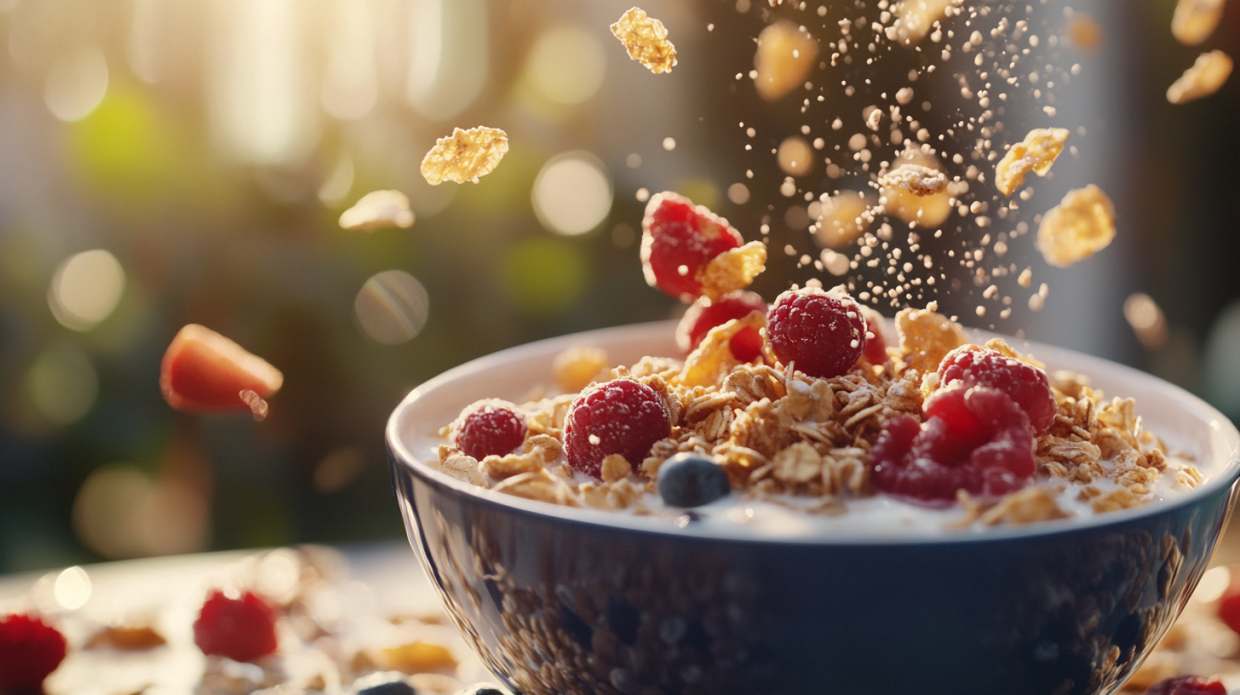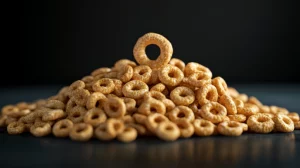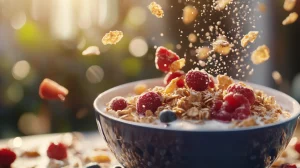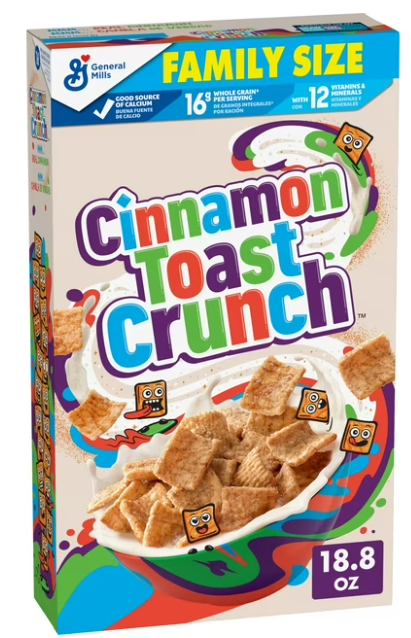
Cinnamon Toast Crunch Breakfast Cereal, Crispy Cinnamon Cereal, Family Size, 18.8 oz
- CINNAMON CEREAL: Crispy cereal squares made from whole wheat and rice, blasted with epic cinnamon sugar CINNADUST; A morning food the whole family can enjoy
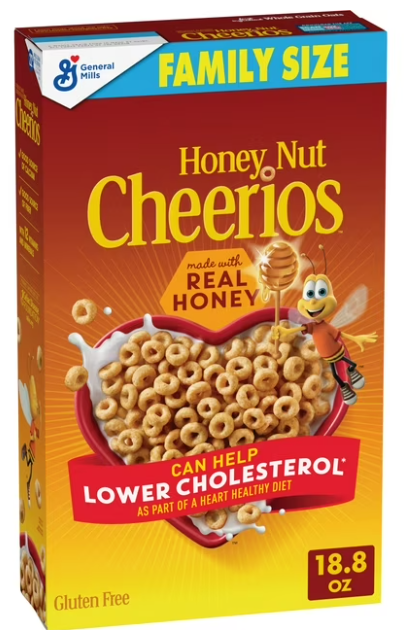
Honey Nut Cheerios, Heart Healthy Gluten Free Breakfast Cereal, Family Size, 18.8 oz
- MADE WITH REAL HONEY: Sweetened whole grain oat cereal with real honey and natural almond flavor in every delicious spoonful; Whole grain oats are the first ingredient in this honey nut cereal for kids and adults; An ideal pantry staple
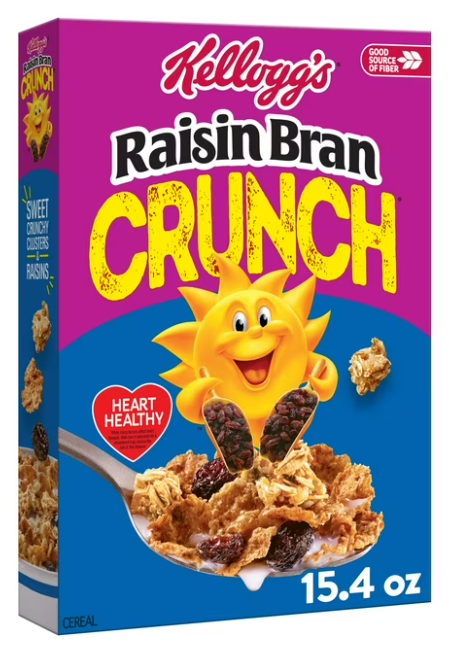
Kellogg’s Raisin Bran Crunch Breakfast Cereal, Fiber Cereal, Family Breakfast, 15.4oz Box (1 Box)
- Healthy cereal bursting with delicious raisins and oat clusters with great flavor and texture in every irresistible spoonful
- Start your day with a family breakfast featuring crispy toasted bran and oat flakes balanced with the satisfying goodness of sweet raisins
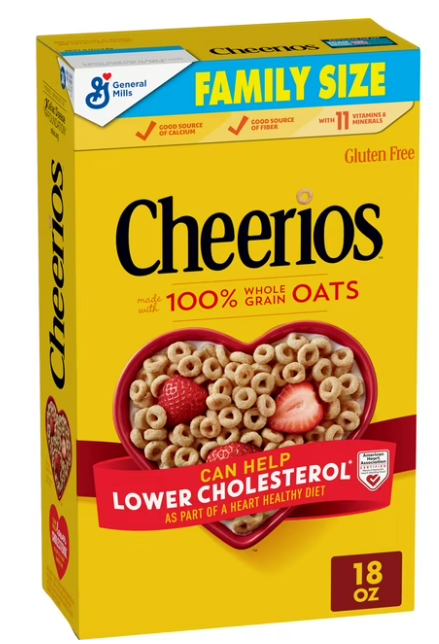
Cheerios, Heart Healthy Gluten Free Breakfast Cereal, Family Size, 18 oz
- PANTRY ESSENTIAL: Made with 100% whole grain oats for a morning food your whole family can enjoy; Keep a box on hand as the perfect pantry staple that’s ready to eat any time
Navigating the Cereal Aisle: Everything You Need to Know About Your Morning Bowl
Breakfast cereals have become a cornerstone of morning routines worldwide, lining supermarket shelves with colorful boxes that promise everything from nostalgic sweetness to cutting-edge nutrition. Whether you’re reaching for that familiar box from your childhood or exploring healthier alternatives, the breakfast cereal you choose can significantly impact your health, energy levels, and overall well-being throughout the day.
As someone who has spent countless mornings contemplating the perfect bowl, I’ve decided to create this comprehensive guide to help you navigate the increasingly complex world of breakfast cereals. From understanding what makes a cereal truly healthy to discovering options that cater to specific dietary needs, this article aims to be your definitive resource for all things cereal.
The Most Popular Breakfast Cereals: Why We Keep Coming Back
When it comes to popularity, certain cereals have maintained their dominance for decades. Cheerios, with its simple oat rings, continues to reign supreme in many households. The brand’s evolution to include varieties like Honey Nut, Multi-Grain, and Chocolate has helped it stay relevant while appealing to different taste preferences.
Frosted Flakes, with its iconic mascot Tony the Tiger, has captured generations with its sweet, crunchy corn flakes. The simple formula of corn flakes coated with sugar creates that perfect combination of sweetness and crunch that many find irresistible first thing in the morning.
Cinnamon Toast Crunch offers that distinctive cinnamon-sugar flavor reminiscent of toast, but in a convenient cereal form. The small squares, coated with cinnamon and sugar, provide a sweet start that somehow feels like comfort food.
Special K has maintained its popularity by positioning itself as a healthier option, particularly among adults watching their weight. Its evolution from a simple rice-based flake to a diverse line including fruits, nuts, and various grains has kept it relevant in a changing marketplace.
What makes these cereals so enduringly popular? It’s a combination of factors:
- Familiar taste that delivers consistent satisfaction
- Strong brand recognition built over decades
- Nostalgic connections to childhood
- Wide availability and relatively affordable pricing
- Effective marketing that spans generations
Yet popularity doesn’t necessarily equate to nutritional value, which brings us to our next important consideration.
Nutritional Champions: The Healthiest Breakfast Cereals
If nutrition is your primary concern, there are excellent options that deliver substantial health benefits without sacrificing too much on taste:
Steel-cut oatmeal stands as perhaps the healthiest “cereal” option, though it requires more preparation than boxed varieties. Rich in soluble fiber, protein, and complex carbohydrates, steel-cut oats help stabilize blood sugar while providing sustained energy.
Ezekiel 4:9 Sprouted Grain Cereal offers a unique nutritional profile thanks to its sprouted grains, which may increase nutrient availability and digestibility. With no added sugars and a good amount of protein (around 8g per serving), it’s a substantial breakfast option.
Grape-Nuts, despite the name containing neither grapes nor nuts, provides impressive nutrition through its simple ingredients of whole grain wheat flour and barley. With 7g of fiber and 7g of protein per serving, it’s surprisingly filling for a cereal.
Barbara’s Puffins have gained popularity among health-conscious consumers looking for lower-sugar options that still offer good taste and texture. With only 5-6g of sugar per serving and a respectable amount of fiber, they strike a reasonable balance.
What makes a breakfast cereal truly “healthy”? Consider these key factors:
- Whole grains listed as the first ingredient
- Minimal added sugar (ideally under 6g per serving)
- Good fiber content (at least 3g per serving)
- Moderate protein content
- Limited artificial ingredients
- Appropriate portion sizes
Remember that even “healthy” cereals can become less so if consumed in large quantities or paired with high-sugar additions.
Gluten-Free Options: Safe Cereals for Those with Sensitivities
For those with celiac disease or gluten sensitivity, finding safe breakfast cereals has become much easier in recent years. Many mainstream companies now offer gluten-free versions of popular cereals, while specialty brands have emerged to serve this growing market segment.
Chex offers several gluten-free varieties including Rice Chex, Corn Chex, and Honey Nut Chex. The simple rice or corn base makes these naturally gluten-free, though it’s always important to verify current formulations as manufacturing processes can change.
Nature’s Path produces an impressive array of certified gluten-free cereals, including their popular Mesa Sunrise flakes and various granola options. Their dedicated gluten-free facility provides additional peace of mind for those with severe sensitivities.
Gluten-free oats from brands like Bob’s Red Mill or GF Harvest offer the nutritional benefits of oatmeal without gluten contamination. While oats are naturally gluten-free, most conventional oats are processed in facilities that also handle wheat, making dedicated gluten-free production essential for sensitive individuals.
When shopping for gluten-free cereals, be aware that:
- A “gluten-free” label means the product contains less than 20 parts per million of gluten
- Some gluten-free cereals compensate for texture with added sugars or refined starches
- Price points are typically higher than conventional cereals
- Cross-contamination can be an issue even with certified products
The quality and variety of gluten-free cereals continue to improve, making breakfast more accessible and enjoyable for those with gluten restrictions.
High-Fiber Champions: Cereals That Keep Things Moving
Dietary fiber plays a crucial role in digestive health, satiety, and even managing cholesterol levels. Many breakfast cereals now emphasize their fiber content as a key selling point.
Fiber One Original stands out with an impressive 18g of fiber per serving, primarily from wheat bran. This represents about 70% of the recommended daily fiber intake in a single bowl, making it particularly effective for those struggling with constipation or trying to increase overall fiber consumption.
All-Bran varieties typically provide 10-12g of fiber per serving, making them another excellent choice for boosting fiber intake. The wheat bran base contributes insoluble fiber that adds bulk to stool and promotes regularity.
Kashi GoLean offers a balanced nutritional profile with 7-8g of fiber alongside 12-13g of protein, making it one of the more filling cereal options. The combination of fiber and protein helps prevent mid-morning hunger that can lead to snacking.
When incorporating high-fiber cereals into your diet, consider these tips:
- Increase fiber intake gradually to avoid digestive discomfort
- Ensure adequate water consumption alongside high-fiber foods
- Be aware that some high-fiber cereals achieve their numbers through added isolated fibers rather than naturally fiber-rich ingredients
- Check that the fiber comes from whole food sources where possible
- Balance soluble and insoluble fiber for optimal digestive health
A high-fiber breakfast cereal can be one of the most effective ways to reach your daily fiber goals while establishing healthy eating patterns for the day ahead.
Weight Management: Cereals That Support Your Goals
For those focusing on weight management, certain cereals may be better suited to support goals than others. The ideal weight management cereal combines moderate calories with satisfying ingredients that prevent overeating later.
Plain shredded wheat offers a simple, unsweetened option with the natural fiber of whole wheat. With no added sugars and a satisfying texture that requires thorough chewing, it promotes mindful eating and satiety.
Kashi 7 Whole Grain Puffs provide substantial volume with minimal calories, creating visual and physical fullness with a relatively small caloric impact. The whole grains provide more staying power than refined alternatives.
Original Cheerios, with just 1g of sugar per serving and a modest 100 calories per cup, offers a familiar taste without excessive calories or sweetness. The oat base provides some soluble fiber that may help with satiety.
When choosing cereals for weight management, consider:
- Portion sizes (which are often smaller than what most people actually pour)
- The total calorie content when milk is added
- Protein and fiber content, which contribute to fullness
- Added sugar, which can trigger cravings
- How satisfying the cereal is (unsatisfying choices may lead to additional snacking)
Remember that weight management is about overall dietary patterns rather than any single food choice, so consider how your breakfast cereal fits into your broader nutritional approach.
Kid-Friendly Cereals: Balancing Nutrition and Appeal
Parents face the perpetual challenge of finding cereals that children will actually eat while providing reasonable nutrition. Several options strike this delicate balance:
Original Cheerios remains a pediatrician-favorite first finger food due to its simple ingredients, low sugar content, and dissolved-in-milk texture that’s appropriate for young eaters. The mild flavor appeals to many children without creating a preference for excessive sweetness.
Kix offers a slightly sweeter option that many children enjoy while still keeping sugar content relatively modest compared to many children’s cereals. The corn-based puffs are easy to eat and dissolve well for younger children.
Barbara’s Organic Honest O’s provides an organic alternative to conventional O-shaped cereals, with whole grain oats and minimal added ingredients. The familiar shape appeals to children while satisfying parents’ desire for cleaner ingredients.
Magic Spoon, though pricier than conventional options, has disrupted the children’s cereal market with its high-protein, low-carb formulations that mimic the colors and flavors of sugary favorites. With whimsical marketing and kid-friendly flavors but adult-friendly nutrition, it represents an interesting new direction.
When selecting cereals for children, consider:
- Sugar content (ideally under 6g per serving for everyday consumption)
- Artificial colors and flavors, which some parents prefer to avoid
- Nutrient fortification, which can help fill nutritional gaps
- Whole grain content for sustained energy
- Portion sizes appropriate for children’s needs
Building healthy breakfast habits early can establish lifelong patterns, making thoughtful cereal choices particularly important for young eaters.
Plant-Based Options: Vegan-Friendly Cereals
For those following plant-based diets, many cereals are naturally vegan, though some contain less obvious animal derivatives that require careful label reading.
Nature’s Path offers a wide range of certified vegan cereals, clearly labeled to make shopping easier. Their EnviroKidz line provides child-friendly options that are also vegan and often organic.
Cascadian Farm produces several vegan-friendly granolas and flaked cereals with clearly labeled ingredients. Their organic certification often appeals to environmentally-conscious vegan consumers.
Many conventional cereals are “accidentally” vegan, including original versions of Cheerios, Chex, Kix, and Life. However, formulations can change, so regular label-checking remains important.
Non-vegan ingredients to watch for in cereals include:
- Vitamin D3 (often derived from lanolin, though some companies now use vegan D3)
- Honey
- Gelatin (sometimes used in marshmallow pieces)
- Milk-derived ingredients in some “frosted” coatings
- Whey or other milk proteins in certain formulations
With plant-based milk alternatives widely available, creating a completely vegan breakfast has never been easier.
Low-Sugar Options: Cereals Without the Sweet Overload
Sugar content varies dramatically across breakfast cereals, from plain varieties with 0g to some children’s cereals exceeding 15g per serving. Several notable low-sugar options stand out:
Plain Shredded Wheat contains zero added sugars, offering only the natural carbohydrates from the whole wheat. This makes it one of the cleanest options available in conventional cereal aisles.
Arrowhead Mills Puffed Rice and Puffed Millet contain no added sugars and just one ingredient each. These simple puffed grains provide texture and volume with minimal processing.
Uncle Sam Original cereal contains just 1g of added sugar per serving, focusing instead on whole grains and flaxseed for nutrition and flavor. The simple ingredient list and significant fiber content make it a nutritionist favorite.
Three Wishes Cereal offers a modern approach to low-sugar cereals with chickpea-based formulations containing only 3g of sugar per serving alongside 8g of protein. Available in flavors like cinnamon and honey, it provides taste without excessive sweetness.
When evaluating sugar content:
- Check both total sugars and added sugars on nutrition labels
- Be aware that serving sizes are often unrealistically small
- Consider how the cereal’s sweetness compares to your other dietary choices
- Remember that naturally occurring sugars in dried fruit additions affect total sugar counts
The difference between a low-sugar and high-sugar cereal can add up to significant sugar consumption over time, particularly for daily cereal eaters.
Fortified for Function: Vitamin and Mineral-Enhanced Cereals
Many cereals are fortified with vitamins and minerals, a practice that began during nutrient shortages and continues today. While whole foods provide nutrients in their natural context, fortification can help address common deficiencies.
Total cereal lives up to its name by providing 100% of the daily value for many vitamins and minerals in a single serving. This high level of fortification can be particularly valuable for those with limited diets or specific nutrient concerns.
Many children’s cereals are heavily fortified with iron, an important nutrient for growing bodies. While the sugar content of these cereals may be concerning, the iron fortification can be beneficial, especially for picky eaters.
Special K varieties are fortified with a range of B vitamins and iron, targeting women’s specific nutritional needs. The brand has successfully positioned itself as supporting women’s health through this targeted fortification.
When considering fortified cereals:
- Remember that synthetic nutrients may not be absorbed or utilized exactly like those from whole foods
- Consider whether you’re getting adequate nutrition from other dietary sources
- Be aware that excessive intake of certain nutrients (particularly fat-soluble vitamins) is possible through heavily fortified foods
- Understand that fortification doesn’t necessarily make a sugary cereal “healthy”
Fortification can be particularly valuable for specific populations with higher nutrient needs or limited dietary variety.
Organic Options: Cereals That Go Beyond Conventional
Organic cereals have grown from niche products to mainstream options, appealing to consumers concerned about pesticide exposure and environmental impact.
Nature’s Path leads the organic cereal market with a diverse range of options from simple flakes to more indulgent granolas. Their commitment to organic ingredients extends across their entire product line.
Barbara’s offers several organic cereal lines that balance nutrition with appealing flavors and textures. Their Puffins and Honest O’s provide more accessible entry points to organic cereals.
Cascadian Farm has established itself as a trusted organic brand available in many conventional supermarkets. Their familiar formats (like Cinnamon Toast Crunch-inspired cereal) make transitioning to organic easier for families.
When shopping for organic cereals:
- Look for the USDA Organic seal for verified certification
- Understand that “organic” refers to production methods, not necessarily superior nutrition
- Be aware that organic cereals can still contain significant amounts of sugar
- Consider the environmental impact of various organic ingredients
- Expect higher price points compared to conventional alternatives
The growth of the organic cereal market has created more options across price points and nutritional profiles, making it easier to find organic options that suit various preferences.
Keto-Friendly Options: Low-Carb Cereal Alternatives
The popularity of ketogenic diets has spawned a new category of specialty cereals designed to provide the familiar breakfast experience with minimal impact on blood sugar and ketosis.
Magic Spoon has pioneered the high-protein, low-carb cereal space with colorful offerings that mimic the experience of conventional cereals while providing only 3-4g net carbs per serving. Using protein isolates, allulose, and other keto-friendly ingredients, they’ve created a product that’s recognizable as cereal while fitting keto macros.
Catalina Crunch offers dense, crunchy squares with 5g net carbs per serving and plant protein from sources like pea protein. Available in familiar flavors like chocolate and cinnamon, it provides substantial texture that stands up well to milk.
NuTrail Keto Nut Granola focuses on nuts and seeds rather than grains, creating a granola-like experience with minimal carbohydrates. The higher fat content aligns well with ketogenic dietary patterns.
When considering keto-friendly cereals:
- Check for net carb counts (total carbs minus fiber and sugar alcohols)
- Be aware that many use alternative sweeteners that may affect individuals differently
- Consider the relatively high price point compared to conventional cereals
- Pay attention to portion sizes, which are often quite small
- Be mindful of highly processed ingredients that may be used to achieve low-carb status
These specialized products have made breakfast more accessible for those following ketogenic dietary patterns, though they typically come at a premium price.
Protein-Packed Options: Cereals That Build and Repair
Protein has become a major selling point for many newer cereals, addressing consumer interest in this satiating macronutrient.
Kashi GoLean stands out with 12-13g of protein per serving, combining soy protein with whole grains for a substantial breakfast. The balanced macro profile makes it more filling than many conventional cereals.
Premier Protein Cereal, from the makers of the popular protein shakes, delivers 20g of protein per serving – comparable to many protein bars or shakes. Using a combination of wheat, corn, and added milk proteins, it significantly boosts the protein content beyond what’s typically found in cereals.
Three Wishes Cereal uses chickpea protein to deliver 8g of protein per serving in a grain-free formula. The simple ingredient list and relatively low carbohydrate content make it appealing to those focusing on protein quality.
When evaluating high-protein cereals:
- Consider the protein source and quality (animal-derived, soy, pea, etc.)
- Check whether added protein comes at the expense of other nutrients
- Be aware that protein content on its own doesn’t determine overall nutritional quality
- Note that highly processed protein isolates differ from proteins in their whole food form
- Remember that excessive protein consumption beyond bodily needs provides no additional benefit
High-protein cereals can be particularly valuable for athletes, older adults, and those struggling to meet protein requirements through other foods.
Allergen-Free Options: Navigating Nut-Free and Other Allergen Concerns
For those with food allergies, finding safe breakfast cereals requires careful label reading and awareness of manufacturing practices.
Many Rice Chex and Corn Chex varieties are made without major allergens and processed in facilities that minimize cross-contamination risks. Their clear labeling practices make them a staple for many allergen-aware households.
Enjoy Life Foods specializes in allergen-free products, including granolas made in dedicated facilities free from the top allergens. Their transparent manufacturing practices provide reassurance for those with severe allergies.
Safe + Fair Food Company produces allergen-friendly cereals with clear labeling about allergen risks. Their dedicated to making allergen information exceptionally clear sets them apart from many mainstream brands.
When shopping with allergen concerns:
- Always check for updated ingredient lists, as formulations change
- Be aware of “may contain” or “processed in a facility” warnings
- Understand that smaller brands often provide more detailed allergen information
- Remember that even “single ingredient” cereals may have cross-contamination risks
- Consider contacting manufacturers directly with specific allergen questions
The growing awareness of food allergies has improved labeling practices, though vigilance remains essential for those with severe allergic reactions.
Diabetes-Friendly Choices: Cereals for Blood Sugar Management
For those managing diabetes, cereal selection requires careful attention to carbohydrate content, glycemic impact, and overall nutritional profile.
Steel-cut oatmeal has a lower glycemic index than many processed cereals, causing a slower rise in blood sugar. The intact oat groats require more digestion time, slowing glucose absorption.
Unsweetened bran cereals typically have a favorable ratio of fiber to digestible carbohydrates, moderating their impact on blood sugar levels. The substantial fiber content helps slow glucose absorption.
Keto-friendly cereals, while developed for ketogenic diets, often work well for blood sugar management due to their low net carb content and higher protein levels.
When selecting cereals with diabetes in mind:
- Consider total carbohydrate content per serving
- Look for higher fiber content that may moderate blood glucose impact
- Be aware of added sugars, even in “healthy-seeming” cereals
- Pay attention to actual portion sizes versus what you typically consume
- Monitor your individual blood glucose response, as it varies person to person
Pairing cereal with protein and healthy fat (like nuts or seeds) can also help moderate the glycemic impact of breakfast.
Clean Label Options: Cereals Without Artificial Ingredients
Consumer demand for simpler, more recognizable ingredients has pushed many cereal manufacturers to reformulate with cleaner labels.
One Degree Organic Foods emphasizes ingredient traceability and purity, even allowing consumers to track the farms where ingredients were grown. Their commitment to sprouted grains and minimal processing appeals to clean-label seekers.
Barbara’s cereals focus on recognizable ingredients without artificial colors, flavors, or preservatives. Their simplified approach to cereal manufacturing addresses growing consumer concern about food additives.
Arrowhead Mills specializes in simple, minimal-ingredient cereals like puffed grain varieties that contain just a single ingredient. This straightforward approach represents the ultimate in clean-label simplicity.
When searching for clean-label cereals:
- Look beyond front-of-package claims to the actual ingredient list
- Be aware that “natural flavors” can encompass a wide range of substances
- Understand that preservative-free products may have shorter shelf lives
- Consider whether organic certification is important alongside clean-label concerns
- Remember that simple ingredients don’t automatically guarantee superior nutrition
The push toward cleaner labels has benefited consumers through greater transparency, though marketing claims still require careful evaluation.
Best-Selling Breakfast Cereals of All Time
The cereal market has seen countless products come and go, but some have achieved legendary status through decades of strong sales.
Cheerios stands as perhaps the most successful cereal brand of all time, with its original version and numerous variations consistently dominating sales charts. Its simple oat rings have become an iconic American food.
Frosted Flakes remains a powerhouse decades after its introduction, with Tony the Tiger’s “They’re Gr-r-reat!” slogan recognized by generations of consumers. The sweet corn flakes have maintained their appeal despite changing nutritional trends.
Special K has successfully reinvented itself multiple times while maintaining strong sales, transitioning from a simple diet cereal to a diverse product line addressing various nutritional concerns.
Cinnamon Toast Crunch has achieved cult-like status with its cinnamon-sugar flavor profile, creating devoted fans who continue purchasing it well into adulthood. Its distinctive taste has inspired numerous brand extensions and imitators.
What makes these cereals so commercially successful?
- Consistent quality and taste over decades
- Strong brand recognition across generations
- Effective marketing campaigns that create emotional connections
- Wide distribution and prominent shelf placement
- Ability to adapt to changing consumer preferences while maintaining core identity
These enduring brands demonstrate how cereals can transcend mere breakfast food to become cultural touchstones.
Behind the Box: How Breakfast Cereals Are Made
The production of breakfast cereals involves sophisticated processes that transform simple grains into the diverse products found on store shelves.
Most flaked cereals begin with a cooking process where grains are softened through boiling or steaming. The cooked grains are then rolled or pressed between heavy rollers to create the characteristic flakes before toasting for crispness.
Puffed cereals utilize pressure and temperature to force steam into the grain kernels. When suddenly released from this pressure, the steam expands rapidly, creating the puffed structure before drying solidifies the shape.
Extruded cereals, including many shaped varieties, involve forcing a dough mixture through specially designed dies that create distinctive shapes. The extruded pieces are then dried and often toasted to create the desired texture.
Granola production typically involves mixing oats and other ingredients with sweeteners and oils, then baking the mixture until it achieves the desired crunch and cluster formation.
Post-production processes often include:
- Vitamin and mineral fortification through spraying or coating
- Addition of flavors, colors, and sweeteners
- Precision cutting to ensure uniform piece sizes
- Quality control for consistency and safety
- Packaging designed for maximum freshness and shelf appeal
Understanding these production methods helps explain the different textures, shelf stability, and nutritional characteristics of various cereals.
International Breakfast Bowls: Cereals From Around the World
While American-style breakfast cereals have achieved global reach, many cultures have their own traditional grain-based breakfast foods that function similarly to cereals.
Muesli, originally developed in Switzerland, combines rolled oats, nuts, seeds, and dried fruits in an uncooked mixture typically soaked in milk or yogurt. Unlike granola, traditional muesli isn’t sweetened or baked, offering a different textural experience.
Porridges appear across cultures, from Scottish oatmeal to Chinese congee to South African maltabella (sorghum porridge). These hot grain cereals represent perhaps the oldest form of cereal consumption, predating modern manufacturing techniques.
Unique commercial cereals like Germany’s Knusper-Müsli, Japan’s Furugura (fruit granola), and Australia’s Weet-Bix demonstrate how cereal traditions have evolved differently around the world, reflecting local tastes and dietary patterns.
As global food culture becomes more interconnected:
- American cereals are adapting flavors for international markets
- Traditional breakfast foods from various cultures are influencing new cereal products
- Innovative ingredients from around the world are appearing in mainstream cereals
- Health trends from different regions are shaping new product development
This cross-cultural exchange continues to expand the definition of what constitutes “breakfast cereal” worldwide.
Low-Carb Alternatives: Beyond Keto-Specific Products
For those seeking to reduce carbohydrate intake without specialty products, several conventional options offer relatively lower carb content.
Plain nut-based granolas often have significantly lower carbohydrate content than grain-based cereals, while providing satisfying crunch and substantial nutrition through healthy fats and protein.
Flaxseed-based cereals like Uncle Sam provide more fiber and protein relative to their carbohydrate content than most conventional cereals, creating a more favorable macronutrient ratio for those monitoring carbs.
Seed-based cereals and grain-free granolas typically offer lower net carbohydrates than traditional cereals, while providing substantial nutrition through diverse ingredients like sunflower seeds, pumpkin seeds, and coconut.
When seeking lower-carb conventional options:
- Compare net carbs (total carbs minus fiber) rather than total carbohydrates
- Consider portion sizes, which dramatically affect carbohydrate intake
- Look for cereals with substantial protein that may improve satiety despite lower volume
- Be aware that many “grain-free” options still contain significant carbohydrates from other sources
These mainstream alternatives can provide accessible options for those reducing carbohydrates without requiring specialty products.
Nostalgic Favorites: Cereals of the 80s and 90s
For many adults, certain cereals trigger powerful nostalgic connections to childhood breakfasts and Saturday morning cartoons.
Cookie Crisp, with its cookie-like appearance and distinctive mascot evolution (from a wizard to a burglar to a wolf), remains a quintessential nostalgic cereal for those who grew up during its heyday.
Fruity Pebbles and Cocoa Pebbles, with their vibrant colors and Flintstones tie-in, represent the character-marketing era of cereals perfectly. Their distinctive texture and milk-transforming abilities created memorable breakfast experiences.
Count Chocula, Franken Berry, and Boo Berry – the “monster cereals” – hold special nostalgic value, particularly since they were often available only seasonally, making them especially anticipated treats.
Nintendo Cereal System, C-3PO’s, Bill & Ted’s Excellent Cereal, and other limited-time promotional cereals hold particular nostalgic value for those who experienced these short-lived novelties during their childhood.
The power of cereal nostalgia has led to:
- Revival of discontinued cereals through limited releases
- Vintage-inspired packaging for special editions
- Adult-oriented marketing that specifically targets nostalgic connections
- Premium pricing for cereals that tap into nostalgic emotions
- Merchandise and collectibles featuring vintage cereal branding
This emotional connection to childhood cereals demonstrates how these products transcend their nutritional purpose to become cultural touchstones.
Conclusion: Finding Your Perfect Bowl
The ideal breakfast cereal is ultimately the one that aligns with your personal nutritional needs, taste preferences, and lifestyle requirements. Rather than prescribing a single “best” option, consider:
- Your specific health goals and dietary requirements
- Realistic assessment of taste preferences and what you’ll actually enjoy eating
- Budget considerations and accessibility of various options
- How different cereals make you feel throughout the morning
- The balance between nutrition and enjoyment that works for your life
The cereal aisle continues to evolve, offering more options than ever before. From grains to grain-free, sugar-loaded to sugar-free, and simple to fortified, the perfect cereal exists for virtually every preference and need.
By understanding what makes different cereals nutritionally valuable, being aware of marketing claims versus reality, and knowing how to read labels effectively, you can navigate this evolving landscape with confidence.
Whether you’re reaching for that nostalgic favorite occasionally or establishing a new routine with a nutritionally optimized choice, the humble breakfast cereal remains a remarkably versatile, convenient, and for many, joyful way to start the day.

